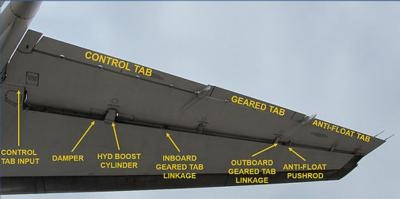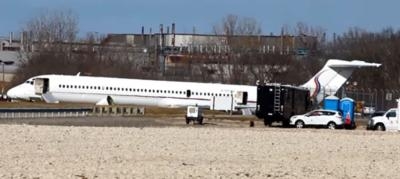Aircraft Came To A Stop About 1,000 Feet Past The Runway Threshold
The NTSB has issued an investigative update for the March 8, 2017, rejected takeoff and runway excursion at Willow Run Airport, Ypsilanti, Michigan.

All 109 passengers and seven crewmembers evacuated Ameristar Air Cargo Inc., flight 9363 via escape slides after the Boeing MD-83 came to rest about 1,000 feet past the end of runway 23L. One passenger sustained a minor injury during the evacuation.
The board said that the update does not provide probable cause for the accident and does not contain analysis of information collected thus far in the NTSB’s ongoing investigation. As such, no conclusions regarding the cause of the incident should be made from this preliminary information.
The following facts are provided as an investigative update:
Parties to the investigation include the Federal Aviation Administration, The Boeing Company and Ameristar Air Cargo, Inc.
Both pilots held airline transport pilot certificates with DC-9-series type ratings (this rating includes the MD-83).
The pilot-in-command, who was the Ameristar chief pilot, was in the right seat and was providing differences training to the captain, who was in the left seat and was the pilot flying the aircraft.
The Ameristar chief pilot had 9,660 total flight hours, with 2,462 hours in DC 9 series airplanes. The captain (flying pilot) had 15,518 total flight hours, with 8,495 hours in DC-9-series airplanes.

Post-accident examination revealed movement of the control column in the cockpit appeared normal; the control columns were free to move, and the elevator control tabs moved as commanded. However, when investigators tried to move the elevator surfaces by hand, the left elevator moved normally, but the right elevator was jammed in a trailing edge-down position (airplane nose down). Upon further inspection, the right elevator geared tab inboard pushrod linkage was found damaged which restricted movement of the right elevator surface but allowed movement of the control tab.
After the damaged components were removed, the elevator could be moved by hand.Examination of the flight data recorder data indicates that during the taxi and take-off roll, the left elevator moved normally, but the right elevator did not move. During takeoff roll, the left elevator began a large airplane nose-up movement (consistent with rotation) at an airspeed of about 152 knots and continued for five seconds to about 166 knots. There was no change in the airplane pitch attitude during this time.
The airplane data then are consistent with the takeoff being rejected. The maximum recorded airspeed was about 173 knots.Review of previous flight data showed normal movement of both the left and right elevator surfaces. The airplane flew to Ypsilanti two days before the accident.The flight and cabin crewmembers indicated in post-accident statements that all slides except for the forward right door deployed correctly. The slide was removed from the airplane and will be examined by investigators at a future date.
No further updates are planned for this investigation. The docket for the investigation will be opened to the public prior to release of the final report.
(Graphic provided with NTSB news release. Aircraft image from YouTube video uploaded by user Mtrain999)
 Bolen Gives Congress a Rare Thumbs-Up
Bolen Gives Congress a Rare Thumbs-Up The SportPlane Resource Guide RETURNS!!!!
The SportPlane Resource Guide RETURNS!!!! Buying Sprees Continue: Textron eAviation Takes On Amazilia Aerospace
Buying Sprees Continue: Textron eAviation Takes On Amazilia Aerospace Hawker 4000 Bizjets Gain Nav System, Data Link STC
Hawker 4000 Bizjets Gain Nav System, Data Link STC Echodyne Gets BVLOS Waiver for AiRanger Aircraft
Echodyne Gets BVLOS Waiver for AiRanger Aircraft




